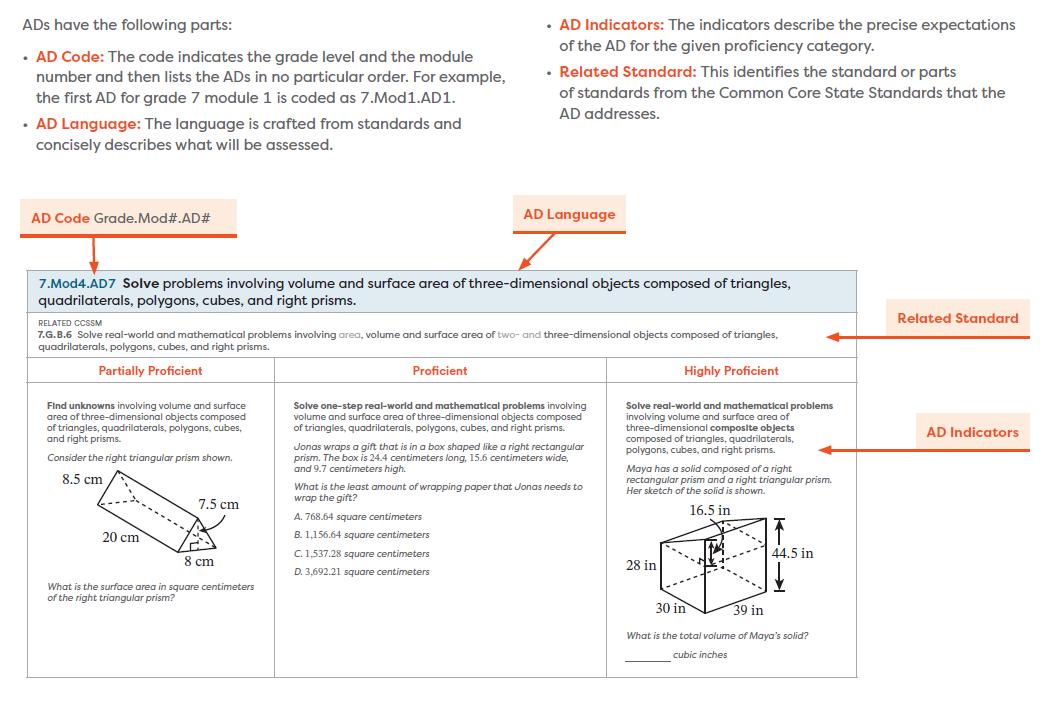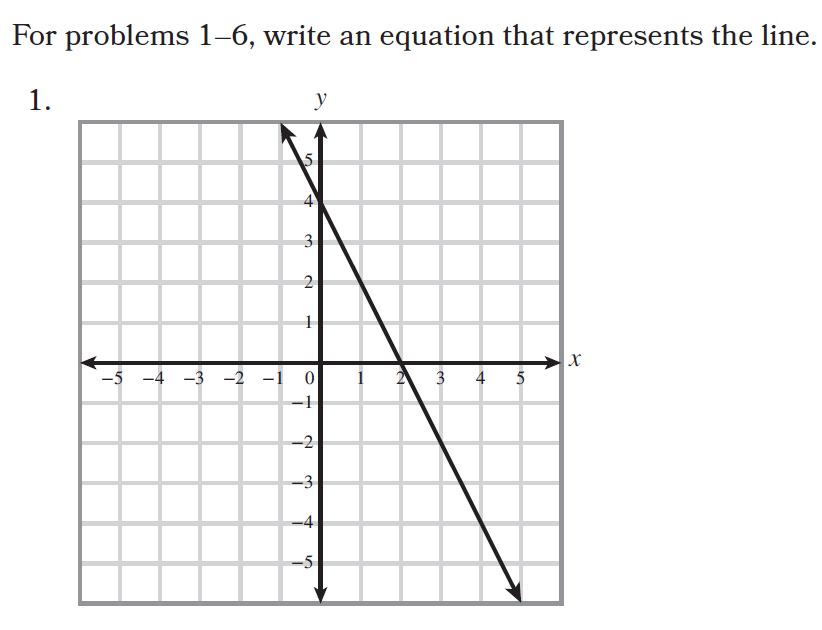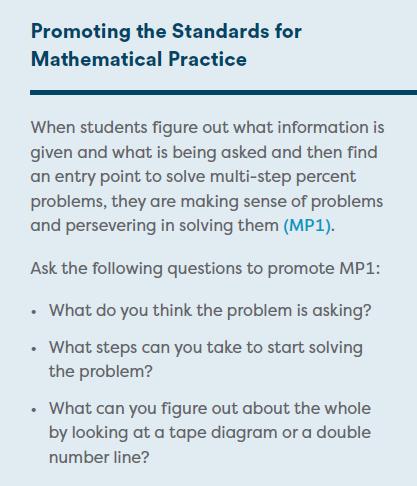
12 minute read
Coherence and Instructional Design
C. Curricular materials connect supporting and additional work to major work in meaningful ways. i. Curricular materials make natural connections between different clusters and domains.
✓ Eureka Math2 lessons and materials make natural connections between different clusters and domains. Whenever possible, the major work of the level is naturally embedded in lessons even when the objective targets supporting or additional work. This natural embedding supports students in making meaningful content connections so that they understand mathematics as a coherent discipline rather than as a series of unrelated topics.
For example, the objectives in module 5 of level 6 target supporting work that appears in the geometry domain: solve real-world and mathematical problems involving area, surface area, and volume. However, the necessary calculations in finding area, surface area, and volume also gives students the opportunity to apply their understanding of the major work that appears in The Number Systems domain: Apply and extend previous understandings of numbers to the system of rational numbers, as well as in the Expressions and Equations domain: Apply and extend previous understandings of arithmetic to algebraic expressions and reason about and solve one-variable equations and inequalities.
At times, conceptual understanding of the major work and additional work is developed simultaneously to make connections between domains. For example, in level 7 module 3 topic B, over the course of four lessons, students learn about angle relationships such as complementary angles, supplementary angles, vertical angles, and angles at a point while concurrently writing and solving progressively more difficult equations to find unknown angle measures.
Curriculum materials also intentionally make important connections among two or more clusters in a domain. For example, in level 6, the clusters in the Expressions and Equations domain build upon each other as students write and evaluate numerical expressions and then algebraic expressions. Later, students use this understanding to solve equations and conclude that an inequality has infinitely many solutions.
2. Coherence and Instructional Design
A. Curricular materials use a logical mathematical progression to build on learning from prior content.
✓ The Eureka Math2 teacher–writers carefully constructed the curriculum as a logical mathematical story. Rather than separate disjointed skills, the concepts within modules and across levels are intentionally coherent and connected to the larger progression of mathematical concepts over time.
Within each lesson, problems and exercises follow an intentional sequence that gradually reduces supports, which promotes student discovery and productive struggle. Through this process, students apply previous knowledge to new learning. A layered approach directs teachers to strategically revisit skills in increasingly complex ways so that students develop proficiency gradually over time.
Teacher–writers intentionally sequenced new learning to build on students’ conceptual understanding from previous learning. Embedded professional development helps teachers understand these choices and realize how the content builds on itself.
For example, the Why section of the level 6 module 2 Overview answers the question, Why is the topic on factors and multiples at the beginning of the module and not at the end? The section explains why the choice was made to introduce this concept first and how teachers can help students build on and apply this learning throughout the school year.
Throughout the modules, teachers will find explicit references to learning from previous grade levels. For example, Module Overviews in the Teach book contain Before This Module and After This Module features, which connect the module’s new learning to that of previous and future modules and grade levels, revealing the coherent structure of the curriculum.
For example, in level 8 module 3, students analyze dilations, construct dilations, and learn that similar figures are figures that can be mapped onto one another by using a sequence of rigid motions or dilations. The Before This Module section informs teachers about the work students have already done in level 7 module 1 around scale drawings and in level 8 module 2 around rigid motions. Then, in the After This Module section, the teacher learns how students will use their knowledge of similar triangles to develop an understanding of the slope of a line in level 8 module 4.
B. Coherent highleverage models are evident within and across grade levels.
✓ Eureka Math2 uses a core set of coherent physical and pictorial models within and across grade levels. Many of the familiar models used in levels K–5 evolve to support students with the growing complexities of mathematics in levels 6–A1. These models activate students’ memory and emphasize how the same math concepts can apply to new, more complex situations. Here are some examples of the coherence of models:
• The area model is used multiply rational numbers and expressions. Once students have knowledge of negative numbers, the area model evolves and students begin referring to it as the tabular model. The tabular model then continues to be utilized to multiply and factor polynomial expressions. The area model is an evolution of arrays that students are familiar with from K–3.
• Number lines are used in levels 6–A1 to compare numbers, order numbers, and represent solutions to inequalities. Modeling on the number line is an evolution of early linear models such as counting on hands and number paths students have experienced in K–5.
o Double number lines are utilized to represent ratio relationships and proportional relationships, solve for unknown values in a ratio relationship or proportional relationship, find unit rates, and solve percent problems.
• Tape diagrams, which students are familiar with from K–5, continue to be utilized in 6–A1 to represent word problems and discover a solution path.
To take one of these examples, consider how the area model, and related tabular model, is a high-leverage model used throughout the curriculum:
Students work extensively with the area model in levels 3–5. For example, in level 3, they use it to find the area of a rectangle. And in level 5, they use it to multiply and divide multi-digit numbers.
In level 6, student use the area model to understand what makes terms like terms and then use it to add and subtract like terms.
Once students have experience with negative numbers in level 7, they realize that area cannot be represented with a negative number. They continue to use the area model and begin referring to it as the tabular model.


In Algebra 1, students continue to use the tabular model to multiply and factor polynomial expressions.
C. Curricular materials include an intentional sequence for developing academic and mathematical language within and across grade-level courses.
Eureka Math2 uses accurate terminology that remains consistent across grade levels. This ensures that younger students are prepared for later grade levels and will recognize concepts they have already learned.
The Terminology resource in the Teach book of each module lists the specialized language of mathematics that is used throughout a module. The resource includes new and familiar terminology with definitions and descriptions from the module. Items in the New category are domain-specific words that are introduced to students in the module. These items include the definition, description, or illustration as it is presented to students. At times, this resource also includes language for teachers that expands how the words are used with students. This extra guidance is set in italics and follows the term it refers to. Items in the Familiar category are domain-specific words introduced in prior modules or grade levels.
Terminology is systematically introduced and developed within lessons by using student-friendly descriptions and definitions. Lessons generally create experiences with the relevant concepts or ideas first before introducing a specific term. New terms are formalized through sample dialogue that models use of the term and its definition or description. When new terms are introduced, instructional recommendations are included either in the teacher guidance of the lesson or in a language support margin note. Examples of these recommendations include constructing or coconstructing a graphic organizer, engaging in a visual representation, or authentically using the word. Students formalize terminology after those experiences so that the new language comes as students need it to describe, reflect on, or name their work. After developing understanding of domain-specific terminology, students are encouraged to attend to precision by using vocabulary correctly.
Academic verbs are also identified in the Terminology resource of the module in which they are introduced. The introduction of academic verbs such as summarize, approximate, and validate are intentionally distributed and sequenced across grade levels. When introduced, academic verbs are always paired with student-friendly language to support understanding.
The last sentence of the Lesson at a Glance states whether any terminology is introduced in the lesson. New domain-specific terminology is also made bold in the lesson text when it is introduced. Often, terminology has accompanying Language Support notes. Students and caretakers can find new terminology and definitions in the Recap for each relevant lesson in the student’s Learn book.
D. Curricular materials utilize a consistent module and lesson structure, including a variety of welldesigned teacherfacilitated experiences.
✓ Well-designed teacher-facilitated experiences that vary in setting and tempo have the highest capacity for equitably building new knowledge and should therefore be the primary mode of instruction. These experiences should include periods of whole-class engagement, small-group and paired collaborations, and independent reflection and processing to accommodate a variety of learning needs. Facilitation styles and lesson experiences also vary—explicit instruction, inquiry, guided discovery, etc.
Eureka Math2 maintains a consistent structure and design across all grade levels. Each level is composed of six modules, with each module further divided into topics. Inside topics, each lesson consists of the same four components: Fluency, Launch, Learn, and Land.
The first component, Fluency, provides distributed practice with previously learned material. Fluency activities are included with each lesson, but they are not accounted for in the overall lesson time. They are meant to be used as bell ringers, or, in a class period longer than 45 minutes. Fluency activities are designed to prepare students for new learning by activating prior knowledge and bridging small learning gaps
The second component, Launch, creates an accessible entry point to the day's learning. Low-floor/high-ceiling activities build context and often
E. Students' ideas are valued and seen as resources for learning.
✓ Math is a social activity, and everyone benefits from learning interactively about mathematics and from one another’s thinking. Lessons support a growth mindset (“I/you can learn mathematics.”), provide opportunities for students to engage in productive struggle, and help them feel they belong in the larger community of student-mathematicians. Students come to see that they are capable in mathematics and that what they contribute is valuable to the math community they are a part of.
Through rich, relevant, and rigorous tasks and opportunities for discourse, students and educators deepen their understanding of both the mathematics and one another. The math writing team used a wide research base, including Mary Kay Stein and Peg Smith's 5 Practices for Orchestrating Productive Mathematics Discussions, to support teachers in engaging students with these tasks and conversations.
Every lesson offers classroom discussions, partner or group talk, and rich questions to promote student discourse and elevate student metacognition. Many lessons highlight and provide opportunities for students to generate and share multiple solution pathways and representations. The lesson provides support through suggested routines, sample responses, discussion questions, and more to guide teachers through the 5 Practices framework to anticipate, monitor, select, sequence, and connect student responses.
F. Curricular materials build knowledge of not only key ideas in mathematics but also knowledge of the world.
✓ Eureka Math2 builds mathematical knowledge in the context of real-world situations. As such, Eureka Math2 incorporates other disciplines, such as fine art and history, that encourage students explore what math can teach about the world around them.
Each module integrates a stunning work of fine art that has a connection to the math learning in the module. The cover art and other carefully curated pieces of art and artists are discussed or analyzed in at least one lesson per module.
In addition, each module contains a Math Past resource. Math Past tells the history of a big idea that has shaped the mathematics introduced in the module. The content in each Math Past highlights contributions from cultures around the world. It presents students with history that frames mathematics exploration as a human endeavor by telling the story of the discipline through artifacts and discoveries.
Wordless context videos also serve as an engaging format for students to make observations and develop questions. These videos appear frequently and provide access to a mathematical context. Students use the context for their own mathematical wonderings and to generate discourse as they create their own word problems and answer their own questions.
G. Curricular materials are research-based.
Experienced and qualified teacher–writers applied eight years of Eureka Math classroom experiences, student data, and current educational research to create Eureka Math2 . Highly educated mathematicians collaborated during the architecture phase of writing and performed thorough reviews of all curricular materials. Writing editors and math auditors also reviewed all materials.
This thorough research informed the instructional design of the curriculum, guiding decisions in each lesson, topic, and module to combine best practices in pedagogy with rigorous math content. The research base includes the Progressions for the Common Core State Standards in Mathematics and texts related to mathematics and mathematical strategies, pedagogy and teaching philosophy, history of mathematics, instructional strategies, and coherence among the mathematical concepts. At the end of each module’s Teach book, a Works Cited section outlines
create productive struggle that leads to a need for the learning that follows. Launch closes with a transition statement that makes the learning objective clear to all students. In alignment with Universal Design for Learning guidelines, the transition statement is written in student-friendly language and conveys the goals of the lesson so students can self-monitor their progress toward meeting the lesson objective.
The next component, Learn, presents new learning related to the lesson objective, usually through a series of instructional segments. This lesson component fills most of the instructional time. Suggested facilitation styles vary and may include direct instruction, guided instruction, group work, partner activities, interactive video, or digital elements.
The final component, Land, is a brief discussion to close the lesson and provides students with an opportunity to complete the Exit Ticket. Suggested questions, including Key Questions related to the objective, help students synthesize the day’s learning. The Exit Ticket provides a window into what students understand to inform the teacher’s instructional decisions about what they need next.







